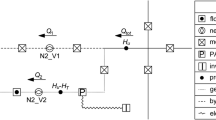Abstract
Ageing water infrastructure is one of the major problems faced by water utilities around the world at present, and urgent solutions are required in order to maintain the integrity of the water supply network. In order to use pipe failure prediction models, accurate information about loads acting on these pipes is important. Water pressure (steady-state and transient) is one of the key loads that needs to be estimated accurately in order to improve the predictability of pipe failures. This paper reports the results of a pressure monitoring program, which was conducted to measure pressure fluctuations during events of pressure transients in three selected network sections in Australia. Pressure measurements were conducted in network sections which were considered as susceptible to pressure transients. Potential sources of pressure transients were identified, and high speed data loggers were installed in selected locations of each network to measure and monitor pressure transients. Pressure transients that were generated during normal operation were measured for a period of one month in each selected section. Further, some of the pressure transients were manually made to simulate the different pressures due to pump start-ups within the network. Pressure fluctuations that could potentially lead to pipe failures were measured at many locations during the monitoring program (several selected failures were reported in this article). Therefore, the effect of pressure transients must not be ignored in pipe failure prediction.








Similar content being viewed by others
References
Chan D, Kodikara J, Gould S, Ranjith P, Choi S-K, Davis P (2007) Data analysis and laboratory investigation of the behaviour of pipes buried in reactive clay. In: Common Ground-Proceedings of the 10th Australia New Zealand Conference on Geomechanics. Australia 206–211
Christodoulou S, Agathokleous A, Kounoudes A, Milis M (2010) Wireless sensor networks for water loss detection. Eur Water 30:41–48
Collins RP, Boxall JB, Karney BW, Brunone B, Meniconi S (2012) How severe can transients be after a sudden depressurization? J Am Water Works Assoc 104(4):E243–E251
Ebacher G, Besner M-C, Lavoie J, Jung B, Karney B, Prévost M (2010) Transient modeling of a full-scale distribution system: comparison with field data. J Water Resour Plan Manag 137(2):173–182
Fleming KK, Dugandzik JP, LeChavellier MW, Gullick RW (2006) Susceptibility of distribution systems to negative pressure transients. American Water Works Association Research Foundation, Denver
Friedman M et al. (2004) Verification and control of pressure transients and intrusion in distribution systems. American Water Works Association Research Foundation, Denver
Haghighi A (2015) Analysis of transient flow caused by fluctuating consumptions in pipe networks: a many-objective genetic algorithm approach. Water Resour Manag 29(7):2233–2248
Jung BS, Boulos PF, Wood DJ, Bros CM (2009) A lagrangian wave characteristic method for simulating transient water column separation. J Am Water Works Assoc 101(6):64–73
Kottmann A (1995) Pipe damage due to air pockets in low pressure piping. 3R International 34:11–11
Large A, Le Gat Y, Elachachi S, Renaud E, Breysse D (2014) Decision support tools: review of risk models in drinking water network asset management. Water Utility Journal 10:45–53
Meniconi S, Brunone B, Ferrante M, Massari C (2011) Small amplitude sharp pressure waves to diagnose pipe systems. Water Resour Manag 25(1):79–96
Rajani B, Abdel-Akher A (2012) Re-assessment of resistance of cast iron pipes subjected to vertical loads and internal pressure. Eng Struct 45:192–212
Rajani B, Kleiner Y (2001) Comprehensive review of structural deterioration of water mains: physically based models. Urban Water 3(3):151–164
Rajani B, Makar J (2000) A methodology to estimate remaining service life of grey cast iron water mains. Can J Civ Eng 27(6):1259–1272
Rajeev P, Kodikara J, Robert D, Zeman P, Rajani B (2014) Factors contributing to large diameter water pipe failure. Water Asset Management International 10(3):9–14
Wood DJ, Lingireddy S, Boulos PF (2005) Pressure wave analysis of transient flow in pipe distribution systems. MWH Soft Press, Arcadia
Wylie EB, Streeter VL, Suo L (1993) Fluid transients in systems. Prentice Hall, Englewood Cliffs
Acknowledgments
This publication is an outcome of the Advanced Condition Assessment and Pipe Failure Prediction Project funded by Sydney Water Corporation, Water Research Foundation (USA), Melbourne Water, Water Corporation, UK Water Industry Research Ltd., South Australia Water Corporation, South East Water, Hunter Water Corporation, and City West Water,. The research partners are Monash University (lead), University of Technology Sydney and University of Newcastle. Author would like to acknowledge Yan Han, Matthew Drafter, Mike Guo, Valid Sourghali, and Duncan Sinclair for their valuable support in field work.
Author information
Authors and Affiliations
Corresponding author
Ethics declarations
Funding
This study was funded by Advanced Condition Assessment and Pipe Failure Prediction Project.
Conflict of Interest
The author(s) declare that they have no competing interests.
Rights and permissions
About this article
Cite this article
Rathnayaka, S., Shannon, B., Rajeev, P. et al. Monitoring of Pressure Transients in Water Supply Networks. Water Resour Manage 30, 471–485 (2016). https://doi.org/10.1007/s11269-015-1172-y
Received:
Accepted:
Published:
Issue Date:
DOI: https://doi.org/10.1007/s11269-015-1172-y




